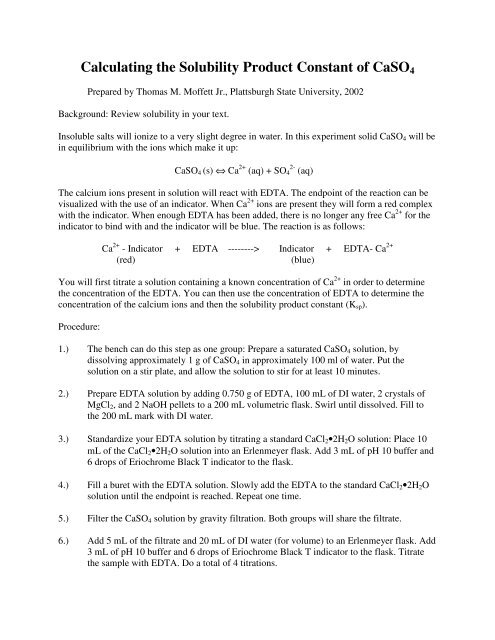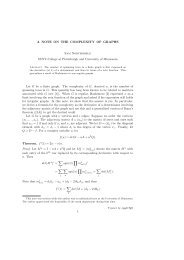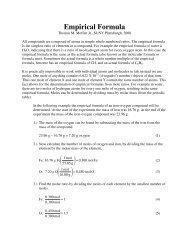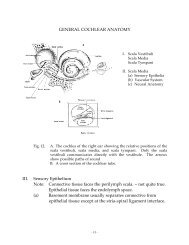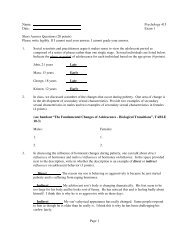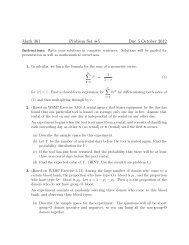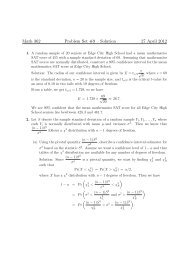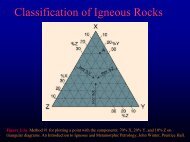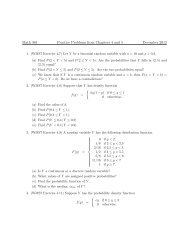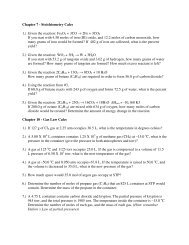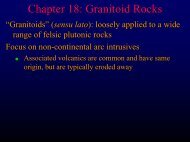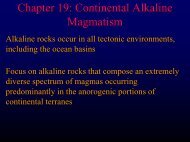Calculating the Solubility Product Constant of CaSO4 - Faculty web ...
Calculating the Solubility Product Constant of CaSO4 - Faculty web ...
Calculating the Solubility Product Constant of CaSO4 - Faculty web ...
- No tags were found...
Create successful ePaper yourself
Turn your PDF publications into a flip-book with our unique Google optimized e-Paper software.
<strong>Calculating</strong> <strong>the</strong> <strong>Solubility</strong> <strong>Product</strong> <strong>Constant</strong> <strong>of</strong> CaSO 4Prepared by Thomas M. M<strong>of</strong>fett Jr., Plattsburgh State University, 2002Background: Review solubility in your text.Insoluble salts will ionize to a very slight degree in water. In this experiment solid CaSO 4 will bein equilibrium with <strong>the</strong> ions which make it up:CaSO 4 (s) ⇔ Ca 2+ (aq) + SO 4 2- (aq)The calcium ions present in solution will react with EDTA. The endpoint <strong>of</strong> <strong>the</strong> reaction can bevisualized with <strong>the</strong> use <strong>of</strong> an indicator. When Ca 2+ ions are present <strong>the</strong>y will form a red complexwith <strong>the</strong> indicator. When enough EDTA has been added, <strong>the</strong>re is no longer any free Ca 2+ for <strong>the</strong>indicator to bind with and <strong>the</strong> indicator will be blue. The reaction is as follows:Ca 2+ - Indicator + EDTA --------> Indicator + EDTA- Ca 2+(red)(blue)You will first titrate a solution containing a known concentration <strong>of</strong> Ca 2+ in order to determine<strong>the</strong> concentration <strong>of</strong> <strong>the</strong> EDTA. You can <strong>the</strong>n use <strong>the</strong> concentration <strong>of</strong> EDTA to determine <strong>the</strong>concentration <strong>of</strong> <strong>the</strong> calcium ions and <strong>the</strong>n <strong>the</strong> solubility product constant (K sp ).Procedure:1.) The bench can do this step as one group: Prepare a saturated CaSO 4 solution, bydissolving approximately 1 g <strong>of</strong> CaSO 4 in approximately 100 ml <strong>of</strong> water. Put <strong>the</strong>solution on a stir plate, and allow <strong>the</strong> solution to stir for at least 10 minutes.2.) Prepare EDTA solution by adding 0.750 g <strong>of</strong> EDTA, 100 mL <strong>of</strong> DI water, 2 crystals <strong>of</strong>MgCl 2 , and 2 NaOH pellets to a 200 mL volumetric flask. Swirl until dissolved. Fill to<strong>the</strong> 200 mL mark with DI water.3.) Standardize your EDTA solution by titrating a standard CaCl 2 •2H 2 O solution: Place 10mL <strong>of</strong> <strong>the</strong> CaCl 2 •2H 2 O solution into an Erlenmeyer flask. Add 3 mL <strong>of</strong> pH 10 buffer and6 drops <strong>of</strong> Eriochrome Black T indicator to <strong>the</strong> flask.4.) Fill a buret with <strong>the</strong> EDTA solution. Slowly add <strong>the</strong> EDTA to <strong>the</strong> standard CaCl 2 •2H 2 Osolution until <strong>the</strong> endpoint is reached. Repeat one time.5.) Filter <strong>the</strong> CaSO 4 solution by gravity filtration. Both groups will share <strong>the</strong> filtrate.6.) Add 5 mL <strong>of</strong> <strong>the</strong> filtrate and 20 mL <strong>of</strong> DI water (for volume) to an Erlenmeyer flask. Add3 mL <strong>of</strong> pH 10 buffer and 6 drops <strong>of</strong> Eriochrome Black T indicator to <strong>the</strong> flask. Titrate<strong>the</strong> sample with EDTA. Do a total <strong>of</strong> 4 titrations.
Post Lab Questions1.) Your calculated K sp most likely came out significantly greater than <strong>the</strong> published value. Thisis due to <strong>the</strong> fact that <strong>the</strong> sulfate ion can act a base. Write a net-ionic reaction showing sulfateacting as a base, and explain why this would lead to an increase in your calculated K sp . (hint:remember Le Chtelier’s Principle)2.) If <strong>the</strong> pH was decreased, would solubility <strong>of</strong> CaSO 4 increase or decrease?3.) A CuCl solution is prepared, where [Cu + ] = [Cl - ] = 2.0 X 10 -4 M. Is <strong>the</strong> solution atequilibrium? Explain4.) Calculate <strong>the</strong> solubility <strong>of</strong> AuI 3 when it is added to a 0.750 M Au(NO 3 ) 3 solution (include allreactions).Pre-Lab Questions1.) What does EDTA stand for?2.) Write <strong>the</strong> K sp expression for CaSO 4 .3.) Which <strong>of</strong> <strong>the</strong> following would increase <strong>the</strong> solubility <strong>of</strong> AgCN (s)?a.) Adding a strong acidb.) Adding NH 3 to form complex ions with Ag +c.) Adding NaCN (aq)d.) Both a and b4.) The molar solubility <strong>of</strong> a slightly soluble ionic compound M 2 X 3 is 2.8 X 10 -6 M. Determine<strong>the</strong> value <strong>of</strong> K sp5.) What is <strong>the</strong> purpose <strong>of</strong> <strong>the</strong> eriochrome black T in this experiment?


